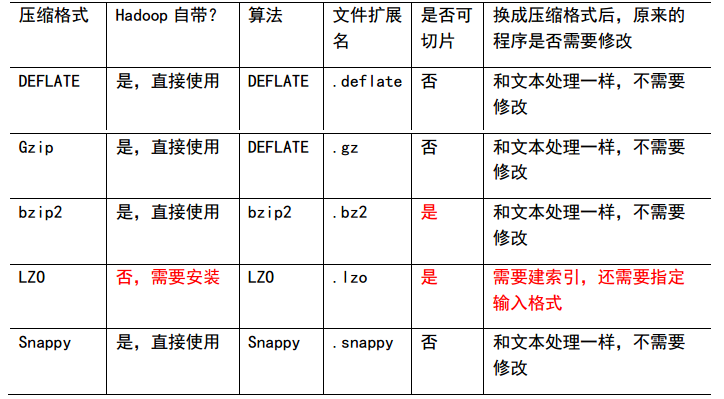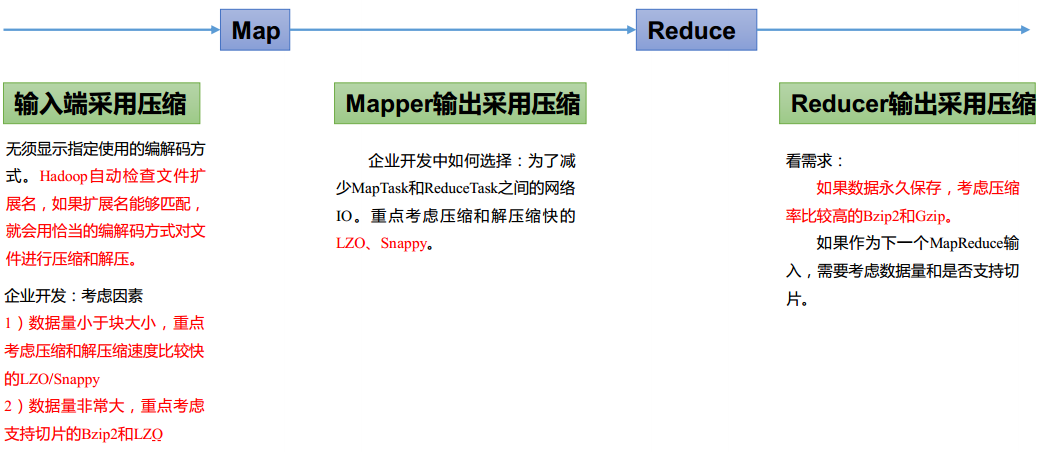八、Hadoop数据压缩
Hadoop数据压缩
文章目录
1. 压缩概述
(1)压缩的好处和坏处
压缩的优点:以减少磁盘 IO、减少磁盘存储空间。
压缩的缺点:增加 CPU 开销。
(2)压缩原则
- 运算密集型的 Job,少用压缩
- IO 密集型的 Job,多用压缩
2. MR支持的压缩编码
(1)压缩算法对比介绍

(2)压缩性能的比较

http://google.github.io/snappy/
Snappy is a compression/decompression library. It does not aim for maximum compression, or compatibility with any other compression library; instead, it aims for very high speeds and reasonable compression. For instance, compared to the fastest mode of zlib, Snappy is an order of magnitude faster for most inputs, but the resulting compressed files are anywhere from 20% to 100% bigger.On a single core of a Core i7 processor in 64-bit mode, Snappy compresses at about 250 MB/sec or more and decompresses at about 500 MB/sec or more.
3. 压缩方式选择
压缩方式选择时重点考虑: 压缩/解压缩速度、压缩率(压缩后存储大小)、压缩后是否可以支持切片。
3.1 Gzip压缩
优点:压缩率比较高;
缺点:不支持 Split;压缩/解压速度一般;
3.2 Bzip2 压缩
优点:压缩率高;支持 Split;
缺点:压缩/解压速度慢。
3.3 Lzo 压缩
优点:压缩/解压速度比较快;支持 Split;
缺点:压缩率一般;想支持切片需要额外创建索引。
3.4 Snappy 压缩
优点:压缩和解压缩速度快;
缺点:不支持 Split;压缩率一般;
3.5 压缩位置选择
压缩可以在 MapReduce 作用的任意阶段启用。

4. 压缩参数配置
(1)为了支持多种压缩/解压缩算法,Hadoop 引入了编码/解码器

(2)要在 Hadoop 中启用压缩,可以配置如下参数

5. 压缩实操案例
Map输出端和Reduce输出端采用压缩
即使你的 MapReduce 的输入输出文件都是未压缩的文件,你仍然可以对 Map 任务的中间结果输出做压缩,因为它要写在硬盘并且通过网络传输到 Reduce 节点,对其压缩可以提高很多性能,这些工作只要设置两个属性即可,我们来看下代码怎么设置。
该案例在WordCount的基础上实现
(1)给大家提供的 Hadoop 源码支持的压缩格式有:BZip2Codec、DefaultCodec
1 | package com.layne.mapreduce.yasuo; |
(2)Mapper和Reduce 保持不变